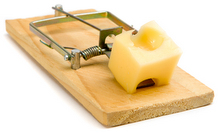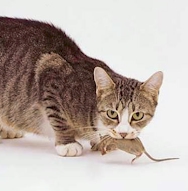What is the best mouse trap? You hear all the time in company meetings and motivational speeches alike, “let’s build a better mouse trap.” It has actually turned into a cliche. But why? Are mouse traps really that bad that someone needs to be thinking about building a better one? Or is it just the perfect item to make a joke about because it really needs no improvement?
I can’t tell. See, I think the absolutely perfect mouse trap would completely disintegrate the mouse. Turn it into energy, or a puff of perfume-laced smoke. Every mouse trap I’ve ever used – though all of them worked effectively – was imperfect in that you still had to deal with the body of the mouse when the deed was done. And that’s the part I think we all dread the most. I mean, who wants to have to touch a nasty, dirty, flea-infested, possible-rabies-carrying carcass? Not I. So let’s take a look at some of the mouse traps available on the market, and discuss the pros and cons of each.
I have used just about all of them in my day, and I do, indeed have some praise and complaint about each of them. The fact that we even have to deal with them at all is maddening to me. But such is life. Recently I took down part of my wall to add a counter top and bar to my garage. And stupidly, haven’t gotten back out there to finish patching up the part of the wall it exposed. I thought nothing of it, honestly. But if you leave an opening like that, the mice (or rats, as it were) will come. There’s really just no two ways about it.
So do you toss a handful of rat poison into the dark depths of your attic? Well, sure. That’s a very easy, hands-off approach to taking care of your infestation. You heard them scratching on the inside of the walls last night? Broadcast some poison across your attic, and you may never even have to see the dirty rodents. And it may kill them off quickly. Sounds great, but what do we do about the bodies? Well, that’s the thing.  They fall where they may, and that’s where they stay. Eventually, they decompose, or the ants come and eat them. But you’re stuck with a rat carcass in your attic (or in the walls) until time has turned it to bones.
They fall where they may, and that’s where they stay. Eventually, they decompose, or the ants come and eat them. But you’re stuck with a rat carcass in your attic (or in the walls) until time has turned it to bones.
The most popular of all mouse traps is the standard old wooden platform with the spring-loaded life-ending snap bar. This one is my favorite for several reasons. Number one, it’s reusable. Assuming you’re dealing with mice, and not rats, you can kill hundreds of them by resetting the trap over and over. You really get your money’s worth. And one of the best parts is that sometimes – like if you’ve set one in a dark closet – you get to hear them go off! One time I set one in my kitchen, then went into the living room to watch television. Before I even got comfortable, SNAP! I had a mouse.
Now the problem with these is that you have to have almost direct contact with the fallen soldier. Especially if you want to reuse the trap. You must lift the bar off the poor little fella’s lifeless mouse body, clean the blood and guts off, and get yourself a new piece of cheese. Me, I prefer peanut butter. You want a mouse? Get you some peanut butter.
Another good one is the plastic box with the one-way door. It’s basically a long rectangular plastic box with a door at one end. The mouse pushes through the door, then it falls shut behind him. The problem with these is that you have to get to it pretty quickly and let the mouse out – because it doesn’t kill them. And if you leave them in there too long, they may eat their way through the plastic. It happens. The other thing is that you are still dealing with a live mouse. You have to find a place to dump the body. A garbage dumpster is good. But if you release him too close to home, he’ll just come right back. And if you plan on letting him go only to kill him, why not just get a Victor? The only advantage I see to one of these is if you’re trying to catch live mice to feed to your pet python. That would be smart spending right there.
One of the newer ideas that is actually growing in popularity is the glue trap. You set out a rectangle of highly adhesive glue-coated cardboard and drop your cheese in the middle. The mouse runs across the board and – well, he doesn’t really run across it. He runs onto it. And that’s all she wrote. He’s never running off of it. The glue is so tacky he basically just becomes one with the board. If you want to pull the mouse off, you’re going to pull him in half, leaving his underside still attached to the trap. This is not the most humane of the traps, in that it leaves the mouse there alive with nowhere to go, until he starves to death. If you don’t care, then you’re good. These are very effective traps, in that several mice can fit on one trap before you get rid of it, and it’s almost guaranteed none of them will actually make it to the bait.
The final one we’ll discuss is the homemade mass grave mouse trap. If you have a heavy infestation, this might be the one for you. You take a five-gallon bucket, fill it halfway with water, then run a long shank or screw across the upper part, right through a can coated with peanut butter. You can then build a ramp from the floor up to the edge of the bucket. The mice run up the ramp, jump across to the can, the can spins and they fall into the water. You could potentially catch twenty or thirty mice in one of these setups. You wouldn’t want to drink that water though.
 So which one works for you? Well, it really depends on where your problem is, how many rodents you’re dealing with, the size of them, and how humane you want to be. In the long run, each of these methods may be just as effective as any other, but each involves a different level of involvement with the dead mouse. If you’re not afraid of the little critters, then – like me – you’ll go for the one with the most potential for complete extinction. When I leave for a trip, I’ll cover a large area of the garage floor with the glue traps. And I expect when I come back I’ll have all the mice taken care of.
So which one works for you? Well, it really depends on where your problem is, how many rodents you’re dealing with, the size of them, and how humane you want to be. In the long run, each of these methods may be just as effective as any other, but each involves a different level of involvement with the dead mouse. If you’re not afraid of the little critters, then – like me – you’ll go for the one with the most potential for complete extinction. When I leave for a trip, I’ll cover a large area of the garage floor with the glue traps. And I expect when I come back I’ll have all the mice taken care of.
Of course, the best trap of all might be the natural one. Get yourself a good mousing cat, and set him loose. You may never see a live mouse again.
